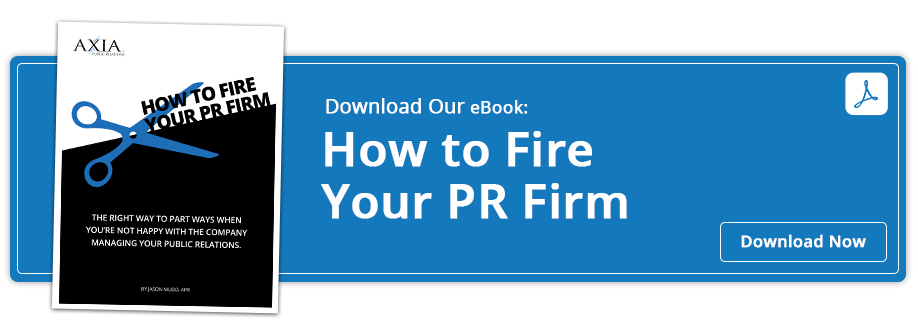How to build a great Request for Proposals that attracts the best PR Agencies
By Axia Public RelationsAugust 31, 2020
A great proposal starts with a great RFP
 Public relations is critical to the success of a company. Your company’s unique needs are important, and finding a partner provider who can solve your problems is critical. A strong, clear request for proposals is the best way to help providers propose creative, relevant, and cost effective business solutions for you.
Public relations is critical to the success of a company. Your company’s unique needs are important, and finding a partner provider who can solve your problems is critical. A strong, clear request for proposals is the best way to help providers propose creative, relevant, and cost effective business solutions for you.
The PR Council offers a free RFP guide to help your company build an RFP that brings you proposals. These proposals work to solve your business challenges, not create more problems and a complicated process. We think it’s a good resource, and we wanted to share it with you here. Before you submit a Request for Proposals, make sure you're working with a proper PR agency.
What to Include
Use the outline below to create an RFP. Feel free to add or remove items that aren’t pertinent to your situation.
Your Company Name
Your Project Title
Statement of Purpose — Briefly summarize what you are seeking and why you are seeking it.
Situation — Describe the challenge, including background information and relevant context. How is the current situation impacting your business?
Company Information — Provide essential background on your organization, website address, and/or other source (e.g. social media accounts) for additional information. Information in this section should enable an agency to make a quick assessment if this company is a good fit with its current client portfolio.
-
What is the mission or purpose of your organization?
-
What is the size and scope of your organization?
-
What sources can you provide for additional information?
Business Objective — Describe what your organization is seeking to achieve and what they expect a public relations firm to do to achieve those objectives.
-
What behavior are we expecting communications to change and how?
-
What are your organization’s key objectives?
-
Within your organization, who is responsible for public relations?
-
Who would oversee the agency?
-
What does success look like?
Audience — Who are you hoping to reach and engage through communications? This includes demographic and geographic objectives, media, and influencers.
Scope of Work
-
Marketing task (e.g. Is this an integrated campaign?)
-
What’s the headline we want to see written?
-
On which channels (online/print media, social media, influencer networks, etc.) do you see this program running and why?
-
Capabilities. Describe core agency services that will be required and, if appropriate, additional areas of expertise or services considered desirable. If there are capabilities that might not be normally considered relevant to this type of assignment but are not needed in this case, mention those as well.
-
Any additional background and considerations
Goals of Project — Use this section to outline your goals for the project with clear objectives.
What Success Looks Like — Use this section to highlight what you believe a successful project will achieve.
Project Timeline — Include information about how you will make a selection and who will be involved. Once you have outlined the ground rules, make sure they are consistently followed throughout the process.
-
What are the steps in the process?
-
Who will be involved in the selection and how?
-
How do you plan to handle questions from and interactions with agencies during the search process?
Opportunities — What upcoming opportunities do you have planned that could assist you in your goals (e.g. new campaign, sponsorship, company policies, initiatives, etc.)?
Bidder Qualifications — Use this section to outline your expectations of bidders. You can request samples of work, contact information, company history, executive background, and any information about the company such as size, organizational chart, or anything else you need to make your decision. You can specify page count for the proposal and the technical expertise required of the bidder. Lastly, you can require bidders to have completed a certain number of similar projects to bid.
Budget — Include an estimated total budget and agency agreement to correspond with the proposed scope of work. If you are uncertain about how much you should invest in public relations, consult with others before beginning a search.*
-
What is the total estimated budget for the scope of work you have proposed? Over what period of time will your project occur?
-
Of this total estimated budget, what portion is labor (agency fees) and what portion is expenses?
Proposal Guidelines/Requirements — Here you provide a detailed list of what the proposal must include as well as the deadline for the proposal. You may want to include language such as:
“This Request for a Proposal represents the requirement for an open and competitive process. Proposals will be accepted until 5 p.m. ___________. Proposals received after this date and time will be returned to the sender. All proposals must be signed by an official agent or representative of the company submitting the proposal. Outsourcing or contracting work must include a name and description of the organizations being contracted.
All costs must be itemized to include an explanation of all fees and costs.
Contract terms will be determined after selecting the winning bid. Any work outsourced to third parties or subcontractors must be clearly stated. All contractors will be reviewed by our legal team. Contracts must be signed by a representative authorized to commit the bidder to the project.”
*Data on public relations budgets may also be found at the PR Management DataSource (PRMD). Created by the USC Annenberg Strategic Public Relations Center, the PRMD is a master database consisting of all the information gathered through the PR Generally Accepted Practice (GAP) Studies conducted by the Center.
Agency Proposal — Please outline the materials you would like to see from responding agencies (agency process, how the agency will achieve targets, explanation of PR agency team and roles, etc.) and any additional information you would like about the agency (locations, expertise, distinguishing capabilities, references, case studies, etc.).
Make sure agencies provide responses to you in a way that will enable you to easily compare and contrast proposals. Critical information to include in this section are deadline for submissions, format (electronic and/or hard copy, length, etc.), person to whom proposals are to be submitted, and all appropriate contact information.
Additional responses to consider:
-
Perspective on the company’s challenges and opportunities
-
Ask agencies to review and analyze information available to them about challenges and opportunities relevant to this search. They may base this on information you provide and/or information they gather from other sources.
-
Agency philosophy on the topic — Agencies are continuously evolving and may have unique perspectives in public relations and related corporate communications disciplines. They may also provide optimal communications approaches to help achieve organizational goals. This may be expressed as a business philosophy or as a point of view on a particular topic.
Evaluation Factors — Use this section to show bidders how you will evaluate their proposal.
Project Documents — Use this section to list any accompanying documents.
Form of Contract — Use this section to include a sample contract for bidders to review if you prefer.
Legal Requirements — Use this section to outline any specific legal requirements you need from bidders such as liquidated damages, etc.
Photo by Startup Stock Photos from Pexels
Topics: public relations, PR tips


Comment on This Article